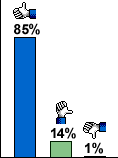 |
Scott Plous, Wesleyan University

Note: To speed up access time, the material in this article appears on a series of web pages, but you may also visit a single page with the full article (useful for printing a paper copy).
| |
This essay is an updated version of the following journal article:
Teaching of Psychology is published by Division 2 of the American Psychological Association (the Society for the Teaching of Psychology). If you print, cite, circulate, or add web links to this page, please include full citation information (links to Teaching of Psychology are also appreciated).
In this article I describe several benefits of using the World Wide Web for instructional purposes, and I offer 8 general tips on how to create and maintain an educational web site. Most of these tips are easy to implement if readers have a basic grasp of hypertext markup language (i.e., the language most web pages are written in, known commonly as HTML). For readers who do not yet have experience with HTML, I provide references for tutorials that cover the essentials in 1-3 days. Throughout the article, I discuss examples from my experience with Social Psychology Network, an educational web site I created in 1996.
Here is an outline of the article:
I. Introduction
II. Getting Started
III. Eight Tips on Building an Effective Web Site:
1. See What's Already Out There
2. Determine Intellectual Property Ownership
3. Plan Ahead
4. Keep Page Loading Time to a Minimum
5. Appearance Matters
6. Seek Feedback
7. Assume Nothing, Check Everything
8. Spend Time Promoting Your Site
IV. Conclusion and References
|

 |

Have you ever considered creating an educational web site for your students? Most newcomers to web development are surprised at how easy it is to design and publish web pages. In my case, I bought a $27 web editing program in January of 1996, and within just a few days, I published a social psychology course syllabus that later grew into an educational web site known as Social Psychology Network. Today, Social Psychology Network receives an average of roughly 3,000 page accesses every 24 hr, and it has grossed a cumulative total of more than two million page accesses.
In this article, I offer tips on how to create and maintain an educational web site, including techniques for attracting visitors to your pages. My focus is on psychology sites developed by faculty at academic institutions, but most tips can also be applied to other educational web sites. Before I begin, however, let me address one of the most common questions that faculty members ask about web development: Is it really worth doing?
In my experience, the answer is unquestionably yes. As long as your institution has a computer infrastructure that can support web pages -- and most colleges and universities do -- there are several reasons why it pays to develop an educational web site. Here are just a few:
- The Internet is here to stay. The Internet has already had a profound influence on higher education, and this influence is projected to grow (Gates, 1997; Rosenberg, 1997; Rudenstine, 1997). Indeed, in some respects the Internet is to today's generation of teachers what personal computers were to the previous generation. As a consequence, "web literacy" will increasingly become a standard tool of the trade, and educational web sites will become regular adjuncts to classroom activities. One of the best ways to stay ahead of the curve is to create an educational web site, even if the site consists of nothing more than an online course syllabus with a small set of course-related web links.
- The web is ideally suited for certain student assignments. Consider, for example, the difficulty many students have understanding the difference between random sampling and random assignment. Much of this confusion would be eliminated if there were a way to have each student personally draw a random sample or conduct random assignment, but it is usually impracticable to arrange this experience for hundreds of students. With the web, however, the impracticable becomes feasible. For instance, when I teach research methods to introductory students, I give them a story problem and direct them to ResearchRandomizer (Urbaniak & Plous, 1998), a web site available through Social Psychology Network. There, students find a brief tutorial and an interactive form that allows them to carry out instant random sampling and random assignment. The students can then print their output from this page, and teaching assistants can quickly look over the answers to make sure there are no errors. I have tried this assignment with more than 500 students, and roughly 95% execute the task perfectly on their first attempt.
- Most students enjoy the web. During the fall
 term of 1998, I anonymously surveyed 210 students at Wesleyan University to see whether they enjoyed having a course web site in social psychology; 85% of students replied affirmatively (fewer than 1% said they disliked having a web site; the rest said they were indifferent). Given the enthusiasm expressed by most students, I now offer optional web assignments to help students learn more about social psychology than they would from the textbook and lectures alone. For instance, I invite students to submit web sites that illustrate topics covered during the previous week, and I post links to the best sites on a web page entitled Sites of the Week. Periodically, I use class time to visit a few of these sites, and the student feedback on these class presentations has been very positive. term of 1998, I anonymously surveyed 210 students at Wesleyan University to see whether they enjoyed having a course web site in social psychology; 85% of students replied affirmatively (fewer than 1% said they disliked having a web site; the rest said they were indifferent). Given the enthusiasm expressed by most students, I now offer optional web assignments to help students learn more about social psychology than they would from the textbook and lectures alone. For instance, I invite students to submit web sites that illustrate topics covered during the previous week, and I post links to the best sites on a web page entitled Sites of the Week. Periodically, I use class time to visit a few of these sites, and the student feedback on these class presentations has been very positive.
- The web can save time and increase convenience. One advantage of posting syllabi and other educational materials on the web is that students have 24-hr access to them. In addition, instructors can post "Frequently Asked Questions" (FAQ) web pages with information on grading, class assignments, study tips, and so forth. By publishing this information on the web, instructors avoid having to answer the same questions throughout the academic term. When I teach Social Psychology, one of the most helpful labor-saving devices I use is GradeGetter, a locally developed web-based program that allows students to enter a personal identification number and check how well they are doing in the class (GradeGetter, 1998). GradeGetter displays a student's exam scores, class assignment scores, and a running point total (taken from values in a spreadsheet), and it provides contextual information on how well the student is doing compared with the rest of the class. By using the web to deliver grade information, individualized performance feedback can be delivered to students without redirecting the instructor's focus from teaching to administrative tasks.
- Web pages can reach a larger and more diverse audience than is otherwise possible. Take, for instance, the case of journal articles. Readership studies suggest that the typical audience of a journal article is quite small (Cohen, 1979; Garvey, Gottfredson, & Simmons, 1984; Wildman & Wildman, 1977). By reproducing an article on the web, however, readership can be dramatically increased. I learned this lesson firsthand in September of 1996, when I created a web version of an article on affirmative action. The hardcopy version of the essay, which appeared in the Journal of Social Issues (Plous, 1996), probably had no more than a few hundred readers, yet by April of 1999 the web page had received more than 20,000 visits [Update: And by July of 2004, more than 500,000 visits.]. Although it is impossible to know how many of these visits represent actual readers of the essay, the number of web-based readers surely exceeds the number of paper-based readers. Even now, three years after the article was first published in paper form, the electronic version continues to get more than 20 visits per day.
One cautionary note: The American Psychological Association (APA) allows authors to post their articles on the web before publication, but because some journals view web-based preprints as a form of prior publication, it is always best to check with the journal editor before posting an article. The APA also allows authors to post published articles as long as explicit permission has been obtained from the publisher (APA, 1997). Thus, if you are interested in creating "e-prints," you should consult with the publisher in question.

|  |



 term of 1998, I anonymously surveyed 210 students at Wesleyan University to see whether they enjoyed having a course web site in social psychology; 85% of students replied affirmatively (fewer than 1% said they disliked having a web site; the rest said they were indifferent). Given the enthusiasm expressed by most students, I now offer optional web assignments to help students learn more about social psychology than they would from the textbook and lectures alone. For instance, I invite students to submit web sites that illustrate topics covered during the previous week, and I post links to the best sites on a web page entitled
term of 1998, I anonymously surveyed 210 students at Wesleyan University to see whether they enjoyed having a course web site in social psychology; 85% of students replied affirmatively (fewer than 1% said they disliked having a web site; the rest said they were indifferent). Given the enthusiasm expressed by most students, I now offer optional web assignments to help students learn more about social psychology than they would from the textbook and lectures alone. For instance, I invite students to submit web sites that illustrate topics covered during the previous week, and I post links to the best sites on a web page entitled